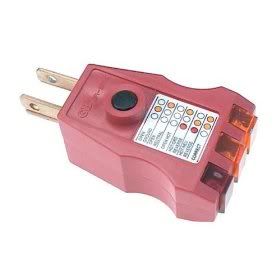wirebender
Senior Member
- Location
- North Central Texas
I was checking receptacles with one of these:

A receptacle (not GFCI) with a MWBC (12/3) made all three lights come on. If I touched my knee to the floor while holding the strap of the receptacle the red light went out.
Everything was properly wired.
Receptacles downstream showed to be okay.
Why the three lights?
At a GFCI receptacle in another location my tester would not trip the GFCI or any downstream receptacles.
I only read 103 volts hot to egc at the GFCI.
What do I need to look for on this?
An open ground upstream?

A receptacle (not GFCI) with a MWBC (12/3) made all three lights come on. If I touched my knee to the floor while holding the strap of the receptacle the red light went out.
Everything was properly wired.
Receptacles downstream showed to be okay.
Why the three lights?
At a GFCI receptacle in another location my tester would not trip the GFCI or any downstream receptacles.
I only read 103 volts hot to egc at the GFCI.
What do I need to look for on this?
An open ground upstream?

